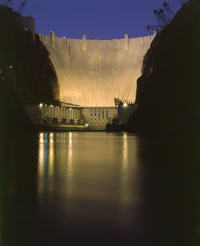Hoover Dam
Frequently Asked Questions - The Dam
Where is Hoover Dam?
In Black Canyon on the Colorado River, about 30 miles southeast of Las Vegas, Nevada.
How tall is Hoover Dam?
It is 726.4 feet from foundation rock to the roadway on the crest of the dam. The towers and ornaments on the parapet rise 40 feet above the crest.
How much does Hoover Dam weigh?
More than 6,600,000 tons.
What type of dam is Hoover?
A concrete arch-gravity type, in which the water load is carried by both gravity action and horizontal arch action.
What is the maximum water pressure at the base of the dam?
45,000 pounds per square foot.
How much concrete is in the dam?
Three and one-quarter million cubic yards. There are 4,360,000 cubic yards of concrete in the dam, powerplant and appurtenant works. This much concrete would build a monument 100 feet square and 2-1/2 miles high; would rise higher than the Empire State Building (which is 1,250 feet) if placed on an ordinary city block; or would pave a standard highway 16 feet wide, from San Francisco to New York City.
The first concrete for the dam was placed on June 6, 1933, and the last concrete was placed in the dam on May 29, 1935. Approximately 160,000 cubic yards of concrete were placed in the dam per month. Peak placements were 10,462 cubic yards in one day (including some concrete placed in the intake towers and powerplant), and slightly over 275,000 cubic yards in one month.
How much cement was required?
More than 5,000,000 barrels. The daily demand during construction of the dam was from 7,500 to 10,800 barrels. Reclamation had used only 5,862,000 barrels in its 27 years of construction activity preceding June 30, 1932.
How was chemical heat caused by setting concrete in the dam dissipated?
By embedding more than 582 miles of 1-inch steel pipe in the concrete and circulating ice water through it from a refrigeration plant could produce 1,000 tons of ice in 24 hours. Cooling was completed in March 1935.
What was an unusual feature of Hoover Dam's construction?
The dam was built in blocks or vertical columns varying in size from about 60 feet square at the upstream face of the dam to about 25 feet square at the downstream face. Adjacent columns were locked together by a system of vertical keys on the radial joints and horizontal keys on the circumferential joints (think "giant Lego set"). Concrete placement in any one block was limited to five feet in 72 hours. After the concrete was cooled, a cement and water mixture called grout was forced into the spaces created between the columns by the contraction of the cooled concrete to form a monolithic (one piece) structure.
What were the principal items of work?
More than 5,500,000 cubic yards of material were excavated, and another 1,000,000 cubic yards of earth and rock fill placed. By feature, this included:
Excavation -- for the diversion tunnels, 1,500,000 cubic yards; for the foundation of the dam, powerplant, and cofferdams 1,760,000 cubic yards; for the spillways and inclined tunnels, 750,000 cubic yards; for the valve houses and intake towers, 410,000 cubic yards; earth and rock fill for the cofferdams, 1,000,000 cubic yards.
In addition, 410,000 linear feet of grout and drainage holes were drilled, and 422,000 cubic feet of grout were placed under pressure.
What were the quantities of principal materials used in the dam?
The principal materials, all of which were purchased by the government, were: reinforcement steel, 45,000,000 pounds; gates and valves, 21,670,000 pounds; plate steel and outlet pipes, 88,000,000 pounds; pipe and fittings, 6,700,000 pounds or 840 miles; structural steel, 18,000,000 pounds; miscellaneous metal work 5,300,000 pounds.
What are the geologic conditions at the dam site?
The foundation and abutments are rock of volcanic origin geologically called "andesite breccia." The rock is hard and very durable.
What were the excavation depths from the rivers's low-water surface to foundation rock?
In the upstream cutoff trench, it was 139 feet. The remaining excavation depths average 110 to 130 feet.
How long did it take to build the dam, powerplant, and appurtenant works?
Five years. The contractors were allowed seven years from April 20, 1931, but concrete placement in the dam was completed May 29, 1935, and all features were completed by March 1, 1936.
How many men were employed during the dam's construction?
A total of 21,000 men worked on the Dam with an average of 3,500 and a maximum of 5,218 daily, which occurred in June 1934. The average monthly payroll was $500,000.
What construction work was necessary before operations started at the dam site?
(1) Construction of Boulder City to house both government and contractor employees; (2) construction of seven miles of 22-foot wide, asphalt-surfaced highway from Boulder City to the Dam site; (3) construction of 22.7 miles of standard-gauge railroad from the Union Pacific main line in Las Vegas to Boulder City and an additional 10 miles from Boulder City to the Dam site; and (4) construction of a 222-mile-long power transmission line from San Bernardino, California, to the Dam site to supply energy for construction.
00
Source - U.S. Department of the Interior - Bureau of Reclamation